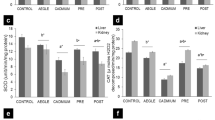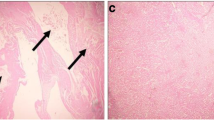Abstract
The effects of chronic exposure to cadmium (Cd) on some selected biochemical parameters, as well as the possible protective role of aqueous extracts of Hibiscus sabdariffa L petal were studied in 12-wk-old male Wistar albino rats. Exposure to Cd caused a significant increase in plasma l-alanine aminotransferases (ALT) only but with a corresponding decrease in liver l-alanine and l-aspartate aminotransferases (L-ALT, L-AST) when compared to the Cd-free control. Total superoxide dismutase activity was decreased in the liver, testis, and prostate of Cd-exposed rats, whereas malondialdehyde (MDA) concentrations were increased relative to the Cd-free control. The metal significantly increased prostatic acid phosphatase activity in the prostate, but decreased the body weight gain of the rats and organ/body weight ratio for prostate and testis compared to the Cd-free control. Pretreatment of rats with aqueous extract of H. sabdariffa resulted in significantly less hepatotoxicity than with Cd alone as measured by plasma ALT and liver ALT and AST activities. The extract also protected the rats against Cd-induced liver, prostate, and testis lipoperoxidation as evidenced by significantly reduced MDA values in these organs, as well as reduced prostatic acid phosphatase activity in the prostate, when compared to the Cd-only exposed rats. Also, when compared to the organ/body weight ratios obtained from rats exposed to Cd alone the prostate and testis were protected by the extract as shown by enhanced prostate/body weight and testis/body weight ratios of Cd- and extract-treated rats. These data suggest that H. sabdarrifa L might be protective in Cd toxicity.
Similar content being viewed by others
References
WHO, Environment Health Criteria, 134, Cadmium, World Health Organization, Geneva (1992).
H. Hu, Heavy metal poisoning, in Harrison's Principles of Internal Medicine, 14th ed, A. S. Focicci, E. Braunwald, K. J. Issalbacher, et al., eds., McGraw-Hill, New York. pp. 2564–2569 (1998).
F. Williams, R. Robertson, and M. Poworth, Scottish Center for Infection and Environment Health: detail profile of 25 major organic and inorganic substances. SCEITH, Glasgow (1999).
S. J. Yin, C. L. Chem, J. Y. Sheu, W. C. Tseng, and T. H. Lin, Cadmium induced renal lipid peroxidation in rats and protection by selenium. J. Toxicol. Environ. Health. 57, 403–413 (1999).
T. Yamano, S. D. Kosanke, and L. E. Rikans, Attenuation of cadmium induced liver injury in senescent male Fisher-344 rats. Role of metallothionein and glutathione, Toxicol. Appl. Pharmacol. 161, 225–230 (1999).
P. B. Ryan, N. Huet, and D. L. Macintosh, Longitudinal investigation of exposure to arsenic, cadmium and lead in drinking water, Environ. Health Perspect. 108, 731–735 (2000).
S. Telisma, P. Coi-Kovic, J. Jurasovic, A. Pizent, M. Gavella, and B. Roac, Semen quality and reproductive endocrine functions in relations to biomakers of lead, cadmium, zinc and copper in men, Environ. Health Perspect. 108, 45–53 (2000).
J. A. Timbrell, Principles of Biochemical Toxicology, 2nd ed., Taylor & Francis, London (1991).
L. J. Goldwater and J. K. Clarkson, Cadmium, in Metallic Contaminants and Human Health, in D. Y. H. Lee, ed., Academic, New York, pp. 97–124 (1972).
H. Yoshioka, Y. Itai, and F. Mitsumori, 31P MNR study of acute toxic effects of cadmium chloride on rat liver, Magn. Reson. Med. 33(b), 795–800 (1995).
D. Manca, A. C. Richard, B. Trottier, and G. Chevalier, Studies on lipid peroxidation in rats tissue following administration of low and moderate doses of cadmium chloride, Toxicology 67, 303–323 (1991).
D. Bagchi, M. Bagchi, E. A. Hassoun, and S. J. Stohs, Cadmium induced excretion of urinary lipid metabolites, DNA damage, glutathione depletion and hepatic lipid peroxidation Sprague-Dawley rats. Biol. Trace Element Res. 52, 143–145 (1996).
S. Gupta, M. Arhar, J. R. Behari, and R. C. Srivastava, Cadmium mediated induction of cellular defense mechanism: a novel example for the development of adaptive response against a toxicant, Ind. Health 29, 1–9 (1991).
S. Sarker, P. Yadav, R. Trivedi, A. K. Bansal, and D. Bhatnagar, Cadmium-induced lipid peroxidation and status of the antioxidant system in rat tissues, J. Trace Elements Med. Biol. 9(3), 144–149 (1995).
H. Horiguchi, M. Sato, N. Konno, and M. Fukushima, Long-term cadmium exposure induces anaemia in rats through hypoinduction of ertheoprotein in the kidneys, Arch. Toxicol. 71, 11–19 (1996).
WHO, Evaluation of Certain Food Additives and Contaminants, Forty First Report of the Joint FAO-WHO Expert Committee on Food Additives, World Health Organisation, Geneva (1993).
FAO-WHO, Toxicological Evaluation of Certain Food Additives and contaminants, WHO Food Additive Series, World Health Organization, Rome (1986).
M. P. Waalkes, S. Rehn, A. O. Parantoni, and T. P. Coogan, Cadmium exposure in rats and tumours of the prostate, in Cadmium in the Human Environment: Toxicity and Carcinogenicity, G. F. Nordberg, R. F. M. Herber, and L. Alessio, eds., International Agency for Research on Cancer, Lyon, pp. 391–399 (1992).
V. Verougstrael, D. Lison, and P. Hots, Cadmium in lung and prostate cancer. a systematic review of recent epidemiological data, J. Toxicol. Environ. Health B: Crit. Rev. 6(3), 227–255 (2003).
K. Robalds and P. Worsfold, Cadmium: toxicology and analysis. A review, Analysis 116, 549–568 (1991).
L. J. Casarett, and J. Doull, Casarett and Doull's Toxicology, Macmillan, New York (1986).
E. Kowalczyk, A. Kopff, P. Fijalkowski, et al. Effect of anthocyanins, on selected biochemical parameters in rats exposed to cadmium, Acta Biochem. Polon. 50(2), 543–548 (2003).
L. M. Perry, Medicinal Plants, of East and Southern Asia, MIT Press, Cambridge, MA (1980).
B. R. Christie, The Handbook of Plant Science in Agriculture, CRC, Boca Raton, FL (1984).
T. H. Tseng, E. S. Kao, C. Y. Chu, F. P. Chou, H. W. Lin Wu, and C. J. Wang, Protective effect of dried flower extract of Hibiscus sabdariffa L. against oxidative stress in rats primary hepatocytes, Food Chem. Toxicol. 35,(12), 1159–1164 (1997).
D. W., Moss, Acid Phosphatase, in Methods of Enzymatic Analysis, 3rd ed., H. U. Bergmeyer, ed., Academic Press, Vol. 4, pp 92–106 (1984).
S. Reithman and S. Frankel, A colorimetric method for the determination of serum glutamic oxaloacetic and glutamic pyruvic transaminases, Am. J. Clin. Pathol. 28, 56–63 (1957).
J. M. C. Gutteridge and S. Williams, Copper dependent hydroxyl radical damage to ascorbic acid, FEBS Lett. 137, 327–329 (1982).
H. P. Misra and I. Fridovich, The role of superoxide ion in the autooxidation of epinephrine and a simple assay for superoxide dismutase, J. Biol. Chem. 247, 3170–3175 (1972).
S. O. Asagba, G. E. Eriyamremu, M. A. Adaikpoh, and A. Ezeoma, Levels of lipid peroxidation, superoxide dismutase and Na+/K+- ATPase in some tissues of rats exposed to a Nigerian-like diet and cadmium, Biol. Trace Element Res. 100(1), 075–086 (2004).
E. Casalino, C. Stano, and C. Landriscina, Enzyme activity alteration by cadmium administration to rats: the possibility of iron involvement in lipid peroxidation, Arch. Biochem. Biophys. 346(2), 171–179 (1997).
J. M. Sauer, M. P. Waalkes, S. B. Hooser, K. K. Kuester, C. A. McQueen, and I. G. Spies, Suppression of Kupffer cell function prevents cadmium-induced hepatocellular necrosis in male Sprague-Dawley rat, Toxicology 121, 155–164 (1997).
J. Blasco and J. Puppo, Effects of heavy metals (Cu, Cd and Pb) on aspartate and alanine aminotransferases in Ruditapes philippinaram (mollusc: bivalvia), Comp. Biochem. Physiol. C: Pharmacol. Toxicol. Endocrinol. 122, 253–263 (1999).
Author information
Authors and Affiliations
Rights and permissions
About this article
Cite this article
Asagba, S.O., Adaikpoh, M.A., Kadiri, H. et al. Influence of aqueous extract of Hibiscus sabdariffa L. petal on cadmium toxicity in rats. Biol Trace Elem Res 115, 47–57 (2007). https://doi.org/10.1385/BTER:115:1:47
Received:
Revised:
Accepted:
Issue Date:
DOI: https://doi.org/10.1385/BTER:115:1:47




